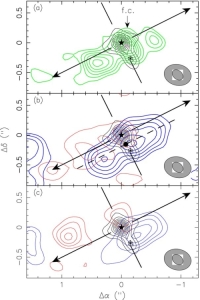 |
|
|
| SMA Research: Star Formation | ||||
|
Massive stars (stars more massive than 8 times that of the Sun) are dominant players in the Galaxy, thus the formation of these stars is an important situation to understand. Young massive stars are found deeply embedded within dense regions or cores of giant molecular clouds. The obscuration of this overlying material generally makes the detection of massive protostars impossible at wavelengths short of the mid-IR.
Low-mass stars like our Sun are formed in the dense cores of large molecular gas clouds. The star formation process is hidden from view at optical wavelengths due to the large amounts of gas and dust surrounding the forming star, and even at infrared wavelengths the most deeply embedded protostars are often difficult to study.
|

HCO+ emission on top of the continuum emission (black contours) for the protostellar system HH 211, observed with the SMA in 2008. The star and asterisk mark positions of continuum sources SMM1 and SMM2, respectively. The arrows indicate direction of the western and eastern components of the jet, and solid lines indicate equatorial plane perpendicular to the jet axis. (Lee et al., 2009, ApJ, 699, 1584L.) | |||
|
|
